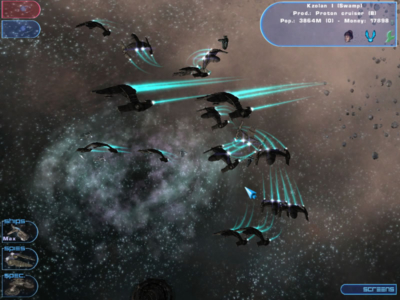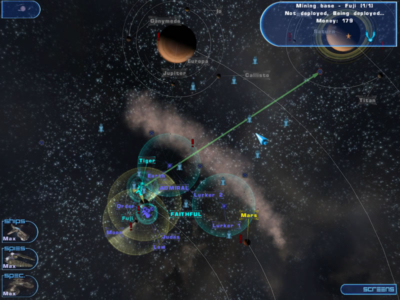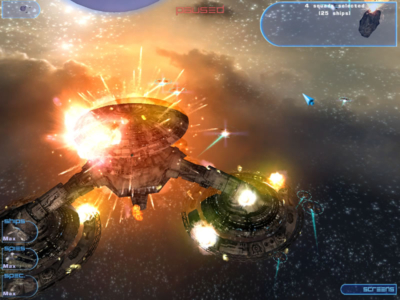
Haegemonia: Legions of Iron
Written by: Stoo
Date posted: July 12, 2007
- Genre: Strategy
- Developed by: Digital Reality
- Published by: Wanadoo
- Year released: 2002
- Our score: 8
My first encounter with this one came around early 2003, watching a video trailer. I was pretty impressed – it showed some of the most amazing graphics I’d seen in a strategy game. Mighty warships cruising through space. Flickering beam cannons and blasts of energy as fleets tore into each other,explosions ripping across their hulls. Planets hanging serenely in space. Glowing engine trails against backdrop of asteroid fields, glowing nebulae and countless glittering stars. I think I must have sat and watched that demo several times over. Homeworld had already done all this of course, and very well too, but it looked a bit Tonka-Toy in comparison to the sheer spectacle here.
So I rushed out and grabbed myself a copy, eager for more sci-fi strategy goodness. Six years down the line though, it’s a “game of the past” and so the sort of thing we like to write about. Also another “oldie” that’s younger than the site itself, which always makes me feel a bit old.
Anyway Haegemonia is brought to us by Hungarian studios Digital Reality, who originally made a minor name for themselves with the Imperium Galactica games. These were space-based strategy of the kind known as 4X; basically empire building. You colonise planets, built fleets, explore the galaxy, research newtechnologies, subjugate your foes and conquer their worlds. IG made a change to the usual formula though by moving from traditional turn-based fare to an entirely real-time structure. Haegemonia is closer to the Command and Conquer model but still carries a bit of that 4x feel. That’s not at all unwelcome, although not something I’d been expecting from the demos.
The game is story-driven and mission based, telling of how humanity unifies within the solar system, then forges ahead claiming new territory in deep space and encountering new civilisations. It’s all a bit functional and dryly depicted. Expect a lot of woodenly animated talking heads, talking about a disaster that has occurred , or what an honour it is to serve with you. I’m sure even I could deliver the lines with a bit more feeling. Still, it’s a structure to hold events together at least.
The maps over which missions are fought place consist of one or more whole solar systems. Planets, asteroids and debris fields are arrayed in front of you. They’re not rendered to scale, but that would be hard to implement in this kind of game anyway. Also I’ll drop my physics hat and leave out grumbling about how planets don’t orbit. The aim here seems to be a sense of scale whilst still having RTS-style maps that a ship can traverse in a reasonable amount of time, and i think the stylised approach works well.
Objectives usually do come down to “blast stuff” or “capture this system” although for variety you might at least be given a defensive mission or intelligence gathering. Secondary objectives pop up from time to time also, in fact I think some are randomised, and they carry minor rewards. Also you’ll usually find several missions in a row taking place in the same systems, before moving onto another set, which adds a feeling of continuity.
For your bases of operations, instead of building them C&C-style, you colonise or capture planets. Within each you have a few parameters to watch over – population, morale, taxation rate. The industrial output of that world can be put to use churning out ships, or upgrading its capabilities with structures like factories or entertainment facilities. You also need to raise money to pay for those ships, and anything else you build. This is more 4X in feel than C&C, although it’s relatively simple in its implementation. There’s not a huge amount of micromanagement on an individual planet, beyond balancing tax rates against morale.
Tax is one source of cash, but you have a few other options too. Mining bases are the most traditional RTS style, parking over an asteroid and gobbling it for minerals. Also though Merchant ships will trundle around gaining revenue wherever they stop. What’s a nice bit of attention to detail though, are recyclcers that will go seek out the wrecks of destroyed ships and turn them into resources.
Research meanwhile is vital to keeping your war machine up to date. It’s fairly familiar to 4X fans again – clicking stuff on menus, then waiting a certain amount of game-time. In any one mission only a certain amount of research can be done, forcing you to choose between the various new toys on offer. The rest will just have to wait for next time. Some options areimprovements to your planets – better factories, recreation facilities for morale and so on. However, you’ll obviously be wanting new ships and new guns for them. There are plenty of options – withimprovements to engines, defenses etc as well as weaponry.
Unfortunately though there are just essentialy four different types of ship to build, from fighter up to battleship. You can choose one of four weapon systems for the larger types, and also between a layout geared more for shooting small fast targets or big slow ones. However the campaign encourages you to stick to one weapon system, and anti-fighter optionss soon become a minor concern. All other upgrades are all auto-applied with no need to choose between once researched. I suppose what i’m getting at is, I wished for either a greater range of set ship types (a la Homeworld) or more options to design my own; something like Master of Orion, even if not necessarily as detailed.
As for combat itself, there’s not a great amount of subtlety and if you’ve ever ordered a bunch of tanks around in C&C you’ll know what to do. Battles are mostly a slogfest – ships encounter each other, line up, trade shots. There’s not much of the rock-paper-scissors dynamics that have become common in strategy either, where a certain unit is vulnerable to another type and very good against a third. It’s just a case of wheeling out the biggest guns you have; with the likes of fighters at most a cheap distraction.
There are a few tactical options though; you can choose between aggressive or evasive behaviour. Also there are options to target hull (raw damage), engines (slow them down) or weapons (disarm them). Also they can gain rank with experience, becoming more powerful, and you can usually choose a few to carry to the next mission. It’s always good to have some battle-hardened veterans around. Just don’t go expecting the depth of battle tactics in Homeworld. Actually I might have liked the formations of that game too, just to add some options and to stop groups of units breaking up and arriving at an enemy target piecemeal.
There’s another important option though, in the form of spy ships – these are unarmed but sneaky and can carry out various missions to undermine the enemy. For example they can steal technology and cash or give you intelligence on the state of a planet. With success they advance in rank and more missions become available, such as sabotaging military bases or even starting riots. Far from a gimmick, they add an extra dimension to play and if used well can give you an edge over the enemy.
That’s all the mechanics of how battles work. Individually, they’re rather simple and small scale. However in a more general sense, over the course of a few missions Haegemonia can produce some exciting campaigns. For example early on, your force (the Legion of Iron itself) is tasked with long-range operations, overseeing colonisation on a number of new systems. It’s all pretty simple stuff, just fending off a few pirates. Then an alien empire arrives and pushes you back in a major way. So a few missions later you’re reclaiming those colonies from invaders and fighting off further attacks, cleaning up one system then charging into another. What’s more, allied (AI controlled) units are carrying out their own battles and protecting our own solar system. So the you do get a sense of taking part in a wider, ongoing conflict, and it’s quite satisfying to guide the Legion to victory.
Note though that it can feel slower at times. That could be the 4x influence again, and for sure Haegemonia is not out to be constant desperate battling. Sometimes you’re just sat back watching colonies develop and money roll in while keeping a wary eye on your neighbours. There were just a few missions that bugged me by giving you at first just one tiny world for revenue, meaning a frustrating start. The problem is exacerbated by how, if cash runs out, all your ships take damage. If the mission is going to have you start with a big fleet (carried over from the last one), couldn’t they at least throw in a lump sum to pay for its upkeep?
Anyway let’s head over to the technical side briefly. About those graphics? Not as impressive as in 2002 of course. Still this remains an attractive-looking game and I can’t think of many modern titles against which it looks badly aged. Ship models are detailed, sometimes with features like weapons pylons extending as they open fire. It’s quite satisfying to watch fleets rumble across a system, then start tearing into each other in a hail of proton blasts. A nice touch is when something big gets destroyed – rather than disappearing in a fireball we see explosions across the surface, and then chunks come flying off.
Now a grumble i sometimes field about space-games is their 2-dimensional nature. As it happens Haegemonia does bring in that up-down axis, although it doesn’t use it a lot. I suppose we could handwave it by saying each map is basically representing a solar system, and those are more or less in a 2D plane by design. Anyway though controls are quite slick and intuitive, as is the rest of the interface. As with most strategy games you might find yourself largely zoomed well out, so as to keep informed on what’s going on around your ships, but it’s easy enough to dart in for a more exciting closeup of the action.
Oh and let’s not forget the soundtrack. It goes for sparkly ambient stuff in quiet times, but more intense orchestral works in battle. Haegemonia isn’t the first game ever to alter the music on the fly like that. However, it seems to have two or three levels of “battle music”, i.e. ramping up in intensity depending on how long the fight lasts. It’s a nice touch, which means the really thundering, pounding stuff is saved for when massed ranks of battleships are flying into clouds of debris.
So overall? Somehow I was never quite amazed as the demos had me expecting. Still, this is a solidly enjoyable title. It’s not quite Homeworld’s tactical 3D dance of cruisers and bombers, but to be fair as I learned over the course of playing this one, it’s not trying to replicate that exact experience anyway. Well, in truth it is yet another RTS. However the pacing is slower and it’s not just about the clash of warships, the emphasis is shifted just a little towards those old games of empire building. Much of the depth is supposed to come from managing your worlds, research, and spy operations.
I do think it could have done better within its own defined parameters, mind you, and that would include fleshing the battles out more. That’s why it’s ultimately a lesser game than Homeworld on our score-o-meter. But if you want a quality session of interstellar warfare, you can’t go far wrong here.





 Posts
Posts